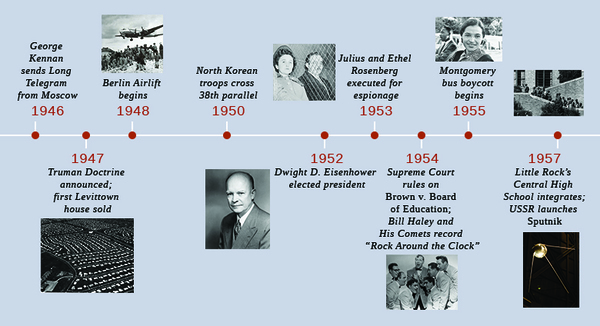| << Chapter < Page | Chapter >> Page > |

The decade and a half immediately following the end of World War II was one in which middle- and working-class Americans hoped for a better life than the one they lived before the war. These hopes were tainted by fears of economic hardship, as many who experienced the Great Depression feared a return to economic decline. Others clamored for the opportunity to spend the savings they had accumulated through long hours on the job during the war when consumer goods were rarely available.
African Americans who had served in the armed forces and worked in the defense industry did not wish to return to “normal.” Instead, they wanted the same rights and opportunities that other Americans had. Still other citizens were less concerned with the economy or civil rights; instead, they looked with suspicion at the Soviet presence in Eastern Europe. What would happen now that the United States and the Soviet Union were no longer allies, and the other nations that had long helped maintain a balance of power were left seriously damaged by the war? Harry Truman, president for less than a year when the war ended, was charged with addressing all of these concerns and giving the American people a “fair deal.”
The most immediate task to be completed after World War II was demobilizing the military and reintegrating the veterans into civilian life. In response to popular pressure and concerns over the budget, the United States sought to demobilize its armed forces as quickly as possible. Many servicemen, labeled the “Ohio boys” (Over the Hill in October), threatened to vote Republican if they were not home by Christmas 1946. Understandably, this placed a great deal of pressure on the still-inexperienced president to shrink the size of the U.S. military.
Not everyone wanted the government to reduce America’s military might, however. Secretary of the Navy James Forrestal and Secretary of War Robert P. Patterson warned Truman in October 1945 that an overly rapid demobilization jeopardized the nation’s strategic position in the world. While Truman agreed with their assessment, he felt powerless to put a halt to demobilization. In response to mounting political pressure, the government reduced the size of the U.S. military from a high of 12 million in June 1945 to 1.5 million in June 1947—still more troops than the nation ever had in arms during peacetime. Soldiers and sailors were not the only ones dismissed from service. As the war drew to a close, millions of women working the jobs of men who had gone off to fight were dismissed by their employers, often because the demand for war materiel had declined and because government propaganda encouraged them to go home to make way for the returning troops. While most women workers surveyed at the end of the war wished to keep their jobs (75–90 percent, depending on the study), many did in fact leave them. Nevertheless, throughout the late 1940s and the 1950s, women continued to make up approximately one-third of the U.S. labor force.

Notification Switch
Would you like to follow the 'U.s. history' conversation and receive update notifications?